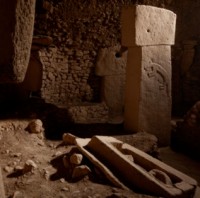Göbekli Tepe
Description
 |
Although construction of the site probably required the cooperation of hundreds of people to move the stone as well as to carve and erect the pillars, there was no sign of habitation and the closest source of water was about three miles away. There was no trace of agriculture nor of cooking fires, although there were numerous ancient flint tools—a Neolithic warehouse of knives, choppers, and projectile points at the location even though the stone had to be lugged from neighboring valleys.
Humans
Much of the human race lived in small nomadic bands that survived by foraging for plants and hunting wild animals. Writing had not been invented, and there was no metal or pottery. To judge by the thousands of gazelle and aurochs bones found at the site, the workers seem to have been fed by constant shipments of game, brought from faraway hunts. All of this complex endeavor must have had organizers and overseers, craftsmen to carve the elaborate figures, people to haul the stones and others to hunt and gather food. Humans had not mastered engineering, so the pillars may have been propped up, perhaps by wooden posts.
Significance
Research at Göbekli Tepe and several other similar sites suggests that the "Neolithic Revolution" was actually carried out by many hands across a huge area and over thousands of years. And it may have been driven not by the environment but by something else entirely. Göbekli Tepe may have been the destination for a religious pilgrimage, a monument for spiritual travelers to be awed by a religious experience—like the travel now made by pilgrims to the Vatican, Mecca, Jerusalem, Bodh Gaya (where Buddha was enlightened), or Cahokia (the enormous Native American complex near St. Louis).
Excerpted and adapted from: Mann, Charles C. 2011. The Birth of Religion. National Geographic Magazine 219(6):34-59.
See also: The Birth of Religion